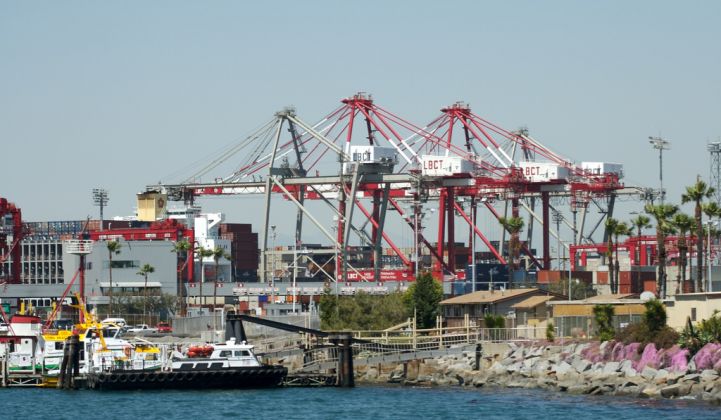Toyota and FuelCell Energy are taking a gamble on the world’s first megawatt-scale carbonate fuel-cell power generation plant with a hydrogen fueling station at the Port of Long Beach, California.
The Tri-Gen plant, built by FuelCell Energy and expected online in 2020, will produce 2.35 megawatts of electricity and 1.2 tons of hydrogen per day to support Toyota’s hydrogen-fueled Mirai sedans and new heavy-duty trucks coming through the port. Power produced from the project will also be sold back to the state’s grid, ensuring another revenue source. Using California agricultural waste to produce hydrogen, it will be the first 100 percent renewable Toyota facility in North America.
The investment indicates Toyota is not letting up on its hydrogen bet, even as electric-vehicle growth accelerates and the carmaker’s hydrogen focus becomes increasingly unique. Elon Musk famously called hydrogen car technology “incredibly dumb.”
In an announcement for its project, Toyota said Tri-Gen represents “a key step forward in Toyota’s work to develop a hydrogen society.” A hydrogen fueling station from Air Liquide is already onsite.
“Toyota has been leading the development of fuel cell technology because we understand the tremendous potential to reduce emissions and improve society,” said Doug Murtha, group vice president of corporate strategy and planning for Toyota Motor Sales, in a statement. “Tri-Gen is a major step forward.”
But even with investment in such a large project, the cards remain stacked against hydrogen.
California, the largest fuel-cell car market in the U.S., has just 31 public hydrogen fueling stations (compared to the state’s over 10,000 public charging stations for EVs). Toyota is working on the development of more stations with Shell, but price and infrastructural challenges -- which have also beleaguered electric vehicles -- continue to hold back hydrogen technology as electric vehicles corner the zero-emissions market. Even Toyota announced last year that it would incorporate more traditional EV models in its lineup.
The Tri-Gen project suggests Toyota’s vision for hydrogen remains the same, though. “We’re not about to give up on hydrogen electric fuel-cell technology,” said company chairman Takeshi Uchiyamada in October.
Accessible fuel at the port also supports another of Toyota’s goals: investing in commercial vehicles. Those vehicles have predetermined routes that ensure fueling infrastructure will see use, which in turn helps to assure return on investment. In April, Toyota announced its “Project Portal” system for fuel-cell heavy-duty trucks with 670 horsepower that emit only water vapor (because of industrial activities, ports are notorious hotspots for pollution). Tri-Gen will fuel up those trucks at the Port of Long Beach and nearby Port of Los Angeles.
The Long Beach project also comes as a vote of confidence in FuelCell Energy, which has been promising profitability for years but has yet to deliver. In 2016, CEO Chip Bottone said FuelCell was “within striking distance.” No fuel cell company has ever been profitable, but Bottone frames the Tri-Gen development as the first in a line of similar projects.
“This is an innovative and replicable global model for building an affordable hydrogen infrastructure to generate renewable transportation fuel that facilitates the wider adoption of fuel cell electric cars, trucks and buses,” he said, in a statement.
FuelCell Energy followed that statement, however, with a note on cautionary language advising investors to not put “undue reliance” on forward-looking statements.




